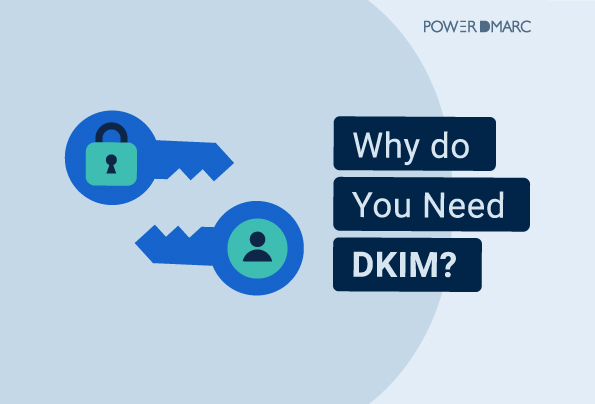Why do You Need DKIM? Isn’t SPF Enough?
Remote working has specifically introduced people to an increased number of phishing and cyberattacks. Mostly, the worst amount of phishing attacks is those that one can’t ignore. No matter the amount of work emails being received and sent, and despite the rise in workplace chat and instant messaging apps, for most people working in offices, email continues to dominate business communication both internally and externally.
However, it’s not a secret that emails are usually the most common entry point for cyberattacks, which involve sneaking malware and exploits into the network and credentials, and revealing sensitive data. According to data from SophosLabs in September 2020, around 97% of the malicious spam caught by the spam traps were phishing emails, hunting for credentials, or any other information.
Out of this, the remaining 3% carried mixed bags of messages that had been carrying links to malicious websites or with those that were booby-trapped attachments. These were mostly hoping to install backdoors, remote access trojans (RATs), information stealers, exploits, or maybe download other malicious files.
No matter what the source, phishing remains a pretty frighteningly effective tactic for attackers, whatever their final objective may be. There are some robust measures all organizations could use to verify as to whether or not an email has come from the person and source that it claims to have come from.
How Does DKIM Come to Rescue?
It must be ensured that an organization’s email security should be able to keep a check on every email that’s incoming, which would be against the authentication rules being set by the domain that the email appears to have come from. DomainKeys Identified Mail (DKIM) is one that helps look into an inbound email, in order to check if nothing has been altered. In the case of those emails that are legitimate, DKIM would definitely be finding a digital signature that would be linked to a specific domain name.
This domain name would be attached to the header of the email, and there would be a corresponding encryption key back at the source domain. The greatest advantage of DKIM is that it provides a digital signature on your email headers so that the servers receiving it can cryptographically authenticate those headers, deeming them to be valid and original.
These headers are typically signed as ‘From’, ‘To’, ‘Subject’, and ‘Date’.
Why Do You Need DKIM?
Experts in the field of cybersecurity state that DKIM is pretty much needed in the day-to-day scenario for securing official emails. In DKIM, the signature is generated by the MTA (Mail Transfer Agent), which creates a unique string of characters called the Hash Value.
Further, the hash value is stored in the listed domain, which after receiving the email, the receiver could verify the DKIM signature by using the public key that is being registered in the Domain Name System (DNS). After this, this key is used to decrypt the Hash Value in the header, and also recalculate the hash value from the email that it received.
After this, the experts would be finding out that if these two DKIM signatures are a match, then the MTA would be knowing that the email hasn’t been altered. Additionally, the user is being given further confirmation that the email was actually sent from the listed domain.
DKIM, which was originally formed by merging two station keys, Domain keys (the one created by Yahoo) and Identified Internet Mail (by Cisco) in 2004, has been developing into a new widely adopted authentication technique that makes an organization’s email procedure pretty trustworthy, and which is specifically why leading tech companies like Google, Microsoft, and Yahoo always check incoming mail for DKIM signatures.
DKIM Vs. SPF
Sender Policy Framework (SPF) is a form of email authentication that defines a process in order to validate an email message, one that has been sent from an authorized mail server in order to detect forgery and prevent scams.
While most people hold the opinion that both SPF and DKIM must be used in organizations, DKIM certainly has an added advantage over the others. The reasons are as follows:
- In DKIM, the domain owner publishes a cryptographic key, which is specifically formatted as a TXT record in the overall DNS record
- The unique DKIM signature that is attached to the header of the message makes it more authentic
- Using DKIM proves to be more fruitful because the DKIM key used by inbound mail servers to detect and decrypt the message’s signature proves the message to be more authentic, and unaltered.
In Conclusion
For most business organizations, not only would DKIM protect their businesses from phishing and spoofing attacks, but DKIM would also be helping in protecting customer relationships and brand reputation.
This is specifically important as DKIM provides an encryption key and a digital signature which doubly proves that an email wasn’t forged or altered. These practices would help organizations and businesses move one step closer to improving their email deliverability and sending a secure email, which would be helping in generating revenue. Mostly, it depends on organizations as to how they would be using it and implementing the same. This is most important and relatable as most organizations would be wanting to free themselves from cyber attacks and threats.
- Rise in Tax Scams and IRS Email Impersonation Attacks During Tax Season - May 2, 2024
- Email Safety 101 to Fight Crypto Scams - April 30, 2024
- How to Find the Best DMARC Solution Provider for Your Business? - April 25, 2024
